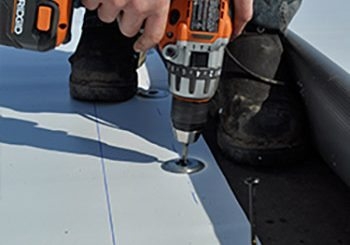Three Fundamentals of a Single Ply Roof
How do you decide what kind of single-ply roof is the right one for your home or business? Well, it depends on many factors but there are basically three fundamentals of a single-ply roof. At Kauffman Roofing in Jamesport, we can walk you through the most important considerations and find the roof that fits your building’s needs.
Let’s take a look at the factors you should consider when choosing a single-ply roof.
- The Building – What is the location at the site, height, floor plate, types and slope of the deck, access to the roof, drainage, amount of equipment on the roof, and the location? If there is an elevator, what is its availability, load capacity, and size?
- The Weather – What is the weather like throughout the year? Will the building be exposed to wind, rain, hail, snow, or hot or cold temperatures?
- The Location – Is your roof easily accessible? Can you get the needed materials and qualified applicators?
- The Use – What are the building and fire codes, zoning laws, and local ordinances that will affect the appearance, working hours, and noise reduction as a new roof is put on?
- Environmental Issues – Are there any environmental concerns that you need to take into consideration?
After we have asked you these questions and we have a better idea of what will work for you, we still have three fundamentals of a single-ply roof to consider. Those are design, installation, and maintenance.
1. Choose the Right Roof Design
You need to find the membrane that works best. Here’s what you should be looking for as you decide on the roof design. First, you need to replace deteriorated, damp or damaged structures so the fastener will properly hold. Your roofing system should also fit the building’s use.
The membrane’s seams are the most vulnerable, so the fewer seams the better. A darker-colored membrane is usually best if the hot days are more than the cool days and a lighter membrane if the cool days are more than the hot days.
Choose the insulation or direct membrane attachment method that works best with the deck type. Screws and plates are used to install single-ply membranes. Screws and plates are better for wood, lightweight concrete, wood fiber, gypsum, and steel decks. Adhesives can also sometimes be used on these decks, depending on the roof being installed, but adhesives work best with concrete decks.
You need a hard substrate to support the membrane. If you don’t, the membrane can be damaged. Finally, make sure the metal termination method is appropriate for the wind conditions because the roof’s termination is even more important in a single-ply roof.
2. Install the Roof Correctly
Once you decide on the right membrane, you need to make sure it is properly installed. Use the right fasteners to connect the metal termination to the substrate. This is crucial to resist wind.
Welded seams should meet the minimum width required by the manufacturer, if they don’t, the seam may not be strong enough or it can cause leaks. That includes the welds at the ends of the seams where the weld changes from a machine-made weld to a hand weld because that is the most common place to find weld defects or missing welds.
During the installation of the roof, use a rounded tip to probe the seams twice a day to tighten the seams. The edges of the membrane should be cleaned before welding or adhering to the seams. Also, because dirt and other contaminants can cause a seam failure and possibly a leak, patches should be placed at the ends of runs where the seams end in a “T.”
There should be no gaps greater than a one-quarter inch between insulation boards or it will weaken the membrane. And always make sure to use enough attachment either adhesive or mechanical. Finally, have walk pads in front of doors and ladders to protect the membrane.
3. Continue Roof Maintenance
Alright, you’ve chosen the best membrane and you’ve had it properly installed. Now you want to keep it in good condition.
Frequently check to make sure the membrane’s seams are intact and there aren’t any loose terminations or punctures in the field membrane or flashings. Even after your roof is installed you should inspect it in the spring and fall or after a major storm. If you see any problems, make the repairs as soon as possible before they become bigger.
Check for any fasteners poking up through the membrane. Fix this as soon as you can. Make sure staff use the walk pads when doing all repairs and inspections. Make sure the correct materials are used for all repairs.
Follow the three fundamentals of a single-ply roof, choose the right roof, install it professionally and correctly, and then maintain it properly. At Kauffman Roofing in Jamesport, we will help you find and install the roof that best serves your home or business.
